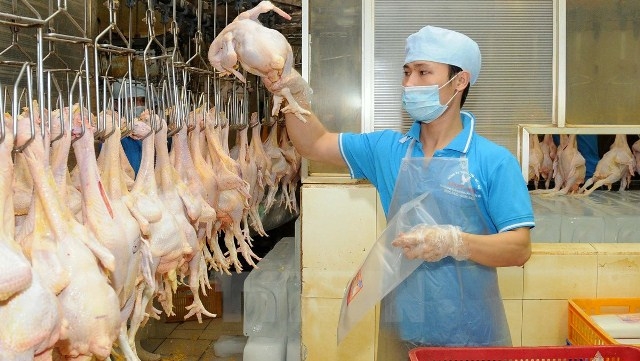


|
Packing chicken products for consumer market in Ho Chi Minh City. (Credit: VNA) In early
September, the poultry sector exported the first consignment of chicken
(approx. 300-400 tonnes) to the Japanese market; until the end of the year,
pork products are expected to receive a "visa" into the fastidious
market in the Netherlands, with approximately 10,000 tonnes per year.
The
export of chickens leading the way for pigs to enter into fastidious markets
marks a significant milestone for the domestic livestock sector. However, in
a comprehensive manner, these figures remain too small for a country with a
large livestock potential such as Vietnam, with total pig heads of 27.5-28
million a year, more than 300 million poultries and 500,000 dairy cows.
Moreover,
each year, agro-forestry and fishery export turnover reaches more than US$30
billion, of which ten main items gain a value of over US$1 billion. However,
the products of the livestock sector only make up a negligible proportion,
especially live weight pigs and products processed from pork, which for many
years have not made any breakthroughs.
Vietnam
has just stopped exporting live weight pigs to the Chinese market through
border routes, while exporting suckling pigs and non-fully-grown pigs to Hong
Kong (China) and Malaysia via official channels, with an estimated output of
20,000 tonnes per year.
The cause
leading to no way out for pork products in both domestic and export markets
is that Vietnam has just ensured the very first stage of the whole chain that
is production organisation, while processing and market activities have not
been concerned yet. The situation led to difficult consumption in the
domestic market, while exports are just "dripping” in small volume and value.
However,
from the lesson of chicken being exported to the fastidious Japanese market,
Vietnam’s husbandry industry has the right to hope that pork will also make
breakthrough.
It is
necessary to reorganise this sector under the chain link model at all levels,
in which, the large scale production by enterprises must be concentrated to
exporting pork, while the medium and small scale production ensures the
supply to the domestic market. It is also important to develop specialty pigs
associated with organic livestock in order to meet the needs of demanding
consumers who require high quality products.
In
addition, investment should be paid in terms of livestock area planning and
the veterinary service from the central to grassroots levels, ensuring the
fulfillment of the national programmes on epidemics prevention and combat,
especially for dangerous animal diseases, such as foot-mouth disease and pork
cholera, as these diseases are under very strict quarantine subjects by
foreign markets.
Furthermore,
the livestock sector should closely coordinate with the Ministry of Industry
and Trade, as well as the trade representative offices of Vietnam in foreign
countries, in order to promote contacts and exchanges between Vietnam and the
markets in huge need, such as Japan, the Republic of Korea and the European
Union to grasp the demand, promote its products and timely resolve any
technical barriers and disputes arising in trading activities with each
importing country.
Hopefully,
synchronous solutions would help, not only with regards to chickens and pigs,
but many other products in Vietnam’s breeding industry to sustainably develop
both the domestic and foreign markets, contributing to improving the status
and image of Vietnamese agricultural products within the international
community.
|